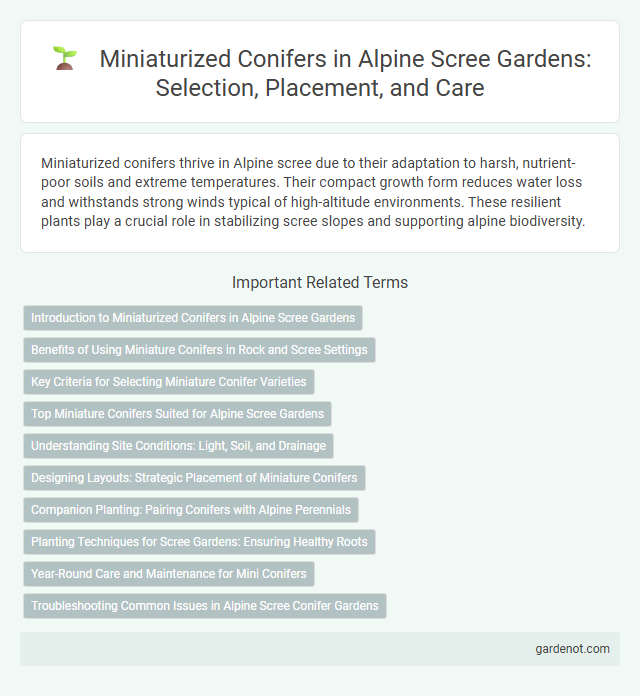Miniaturized conifers thrive in Alpine scree due to their adaptation to harsh, nutrient-poor soils and extreme temperatures. Their compact growth form reduces water loss and withstands strong winds typical of high-altitude environments. These resilient plants play a crucial role in stabilizing scree slopes and supporting alpine biodiversity.
Introduction to Miniaturized Conifers in Alpine Scree Gardens
Miniaturized conifers in alpine scree gardens exhibit exceptional adaptability to harsh environmental conditions, thriving in rocky, well-drained substrates with minimal soil nutrients. These dwarf conifers, such as certain species of Pinus and Juniperus, contribute to biodiversity by providing evergreen structure and resilience against cold temperatures and strong winds. Their slow growth and compact form make them ideal for replicating natural alpine ecosystems, enhancing both aesthetic appeal and ecological stability in garden settings.
Benefits of Using Miniature Conifers in Rock and Scree Settings
Miniaturized conifers thrive in alpine scree environments due to their compact root systems and drought-resistant foliage, enhancing soil stabilization on loose rocky slopes. Their slow growth and low nutrient requirements reduce maintenance needs, making them ideal for conserving fragile scree habitats. These conifers also provide year-round visual interest and habitat for alpine fauna, contributing to ecological diversity in harsh mountainous terrains.
Key Criteria for Selecting Miniature Conifer Varieties
Selecting miniature conifer varieties for alpine scree emphasizes drought tolerance, compact growth habits, and cold hardiness to thrive in harsh, rocky environments. Root system adaptability and slow growth rates minimize maintenance while ensuring longevity and stability on steep slopes. Optimal choices include species with dense foliage and resistance to wind exposure, crucial for withstanding alpine climatic stressors.
Top Miniature Conifers Suited for Alpine Scree Gardens
Top miniature conifers suited for alpine scree gardens include species such as Pinus mugo pumilio, known for its compact growth and tolerance to rocky, well-drained soils. Microbiota decussata offers dense, low-growing foliage that thrives in harsh alpine conditions and adds year-round greenery. These miniature conifers exhibit drought resistance and slow growth rates, making them ideal for the challenging environment of alpine scree landscapes.
Understanding Site Conditions: Light, Soil, and Drainage
Miniaturized conifers thriving in alpine scree exhibit remarkable adaptations to extreme site conditions characterized by intense light exposure, rocky and nutrient-poor soils, and rapid drainage. These species develop dense, needle-like foliage to minimize water loss while maximizing photosynthesis under high UV radiation and fluctuating temperatures. Understanding the microhabitat's soil pH, mineral composition, and moisture retention capacity is crucial for conserving these specialized conifers within fragile alpine ecosystems.
Designing Layouts: Strategic Placement of Miniature Conifers
Strategic placement of miniaturized conifers in alpine scree gardens enhances visual interest and mimics natural mountainous ecosystems. Selecting dwarf varieties such as Pinus mugo pumilio or Juniperus communis var. saxatilis ensures compact growth and resilience to harsh conditions. Positioning these miniature conifers near rocky outcrops or in crevices maximizes drainage and highlights textural contrasts within the layout.
Companion Planting: Pairing Conifers with Alpine Perennials
Miniaturized conifers such as dwarf pines and creeping junipers thrive in alpine scree environments by offering structural stability that supports the delicate root systems of alpine perennials like saxifrage and edelweiss. Companion planting these conifers with nitrogen-fixing alpine legumes enhances soil fertility, promoting robust growth amidst nutrient-poor, rocky substrates. This symbiotic relationship improves moisture retention and microclimate conditions, critical for sustaining biodiversity in harsh high-altitude ecosystems.
Planting Techniques for Scree Gardens: Ensuring Healthy Roots
Miniaturized conifers thrive in alpine scree gardens by requiring well-drained, gritty soil to mimic their natural rocky environment and prevent root rot. Utilizing raised mounds or terraces enhances drainage, while carefully positioning roots during planting encourages strong anchorage and reduces transplant shock. Incorporating coarse sand or fine gravel around the root zone promotes aeration and moisture regulation crucial for healthy root development in scree conditions.
Year-Round Care and Maintenance for Mini Conifers
Miniaturized conifers in alpine scree environments require consistent year-round care to thrive despite harsh conditions. Ensure proper drainage with gritty, well-aerated soil to prevent root rot during winter thaw cycles while providing adequate moisture through deep watering during dry spells. Seasonal pruning promotes compact growth and removes any damaged branches caused by frost or wind exposure.
Troubleshooting Common Issues in Alpine Scree Conifer Gardens
Miniaturized conifers in alpine scree gardens often face challenges such as root rot caused by poor drainage and fungal infections due to excessive moisture. Ensuring well-drained, acidic soil with adequate aeration and using fungicides can effectively prevent these problems. Regular inspection for pests like aphids and spider mites is essential to maintain the health and compact growth of these alpine plants.
Miniaturized conifer Infographic

 gardenot.com
gardenot.com